Occurrence and Concentrations of Toxic VOCs in the Ambient Air of Gumi, an Electronics-Industrial City in Korea
Abstract
:1. Introduction
2. Experimental Section
2.1. Description of Sampling Sites
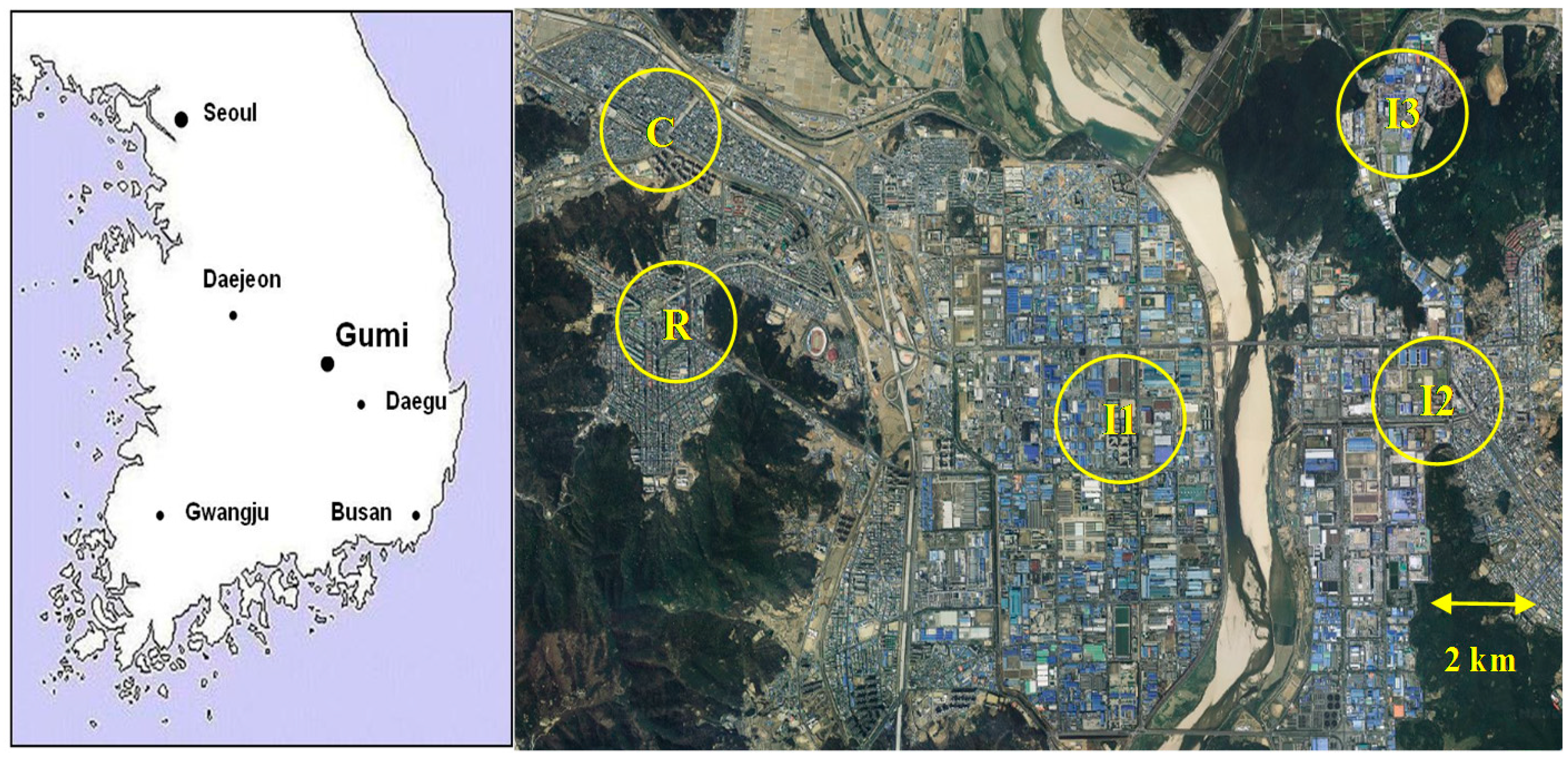
2.2. Sampling Period, Frequency and Duration
| 2003/2004 Campaign | 2010/2011 Campaign | |
|---|---|---|
| Sampling site * | 3 industrial sites (I, II & III) | 2 industrial sites (I & II) |
| 1 residential site | 1 residential site | |
| 1 commercial site | 1 commercial site | |
| Sampling period ** | Winter: 13~19 January 2004 | Spring: 21~27 May 2010 |
| Spring: 9~15 April 2004 | Summer: 3~9 August 2010 | |
| Summer: 13~19 August 2004 | Fall: 15~21 October 2010 | |
| Fall: 15~21 October 2004 | Winter: 5~11 January 2011 | |
| Sampling method | Manual sampling | Automatic sampling |
| Sampling flowrate | 150 mL/min for VOCs | 100 mL/min for VOCs |
| 1 L/min for carbonyls | 1 L/min for carbonyls | |
| Sampling duration | 2.5 h (150 min) for VOCs | 4 h (240 min) for VOCs |
| 2.5 h (150 min) for carbonyls | 2 h (120 min) for carbonyls | |
| Sampling frequency | 3 per day for VOCs and carbonyls | 6 per day for VOCs and 2 per day for carbonyls |
| Number of samples | 507 for VOCs and 476 for carbonyls | 668 for VOCs and 212 for carbonyls |
2.3. Sampling and Analytical Methods
2.4. Target Analytes and Preparation of Standard Samples
2.5. Quality Control and Quality Assurance
3. Results and Discussion
3.1. Occurrence of VOCs in the Ambient Air of Gumi City
| Detection Frequency | First Campaign (2003/2004) | Second Campaign (2010/2011) | ||
|---|---|---|---|---|
| 100%~95% | benzene, toluene, m,p-xylene, pentane, 2-methylpentane, formaldehyde, acetaldehyde, acetone, methyl ethyl ketone | benzene, toluene, ethylbenzene, m,p-xylenes, hexane, vinylacetate, methyl tert-butyl ether, o-xylene, formaldehyde, acetaldehyde, acetone, methy ethyl ketone | ||
| 75%~95% | isopentane, ethylbenzene, isobutane, hexane, dichloromethane, methylcyclopentane, propionaldehyde, trichloroethylene | ethyl acetate, carbon tetrachloride, heptane, 1,2,4-trimethylbenzene, methyl isobutyl ketone, cyclohexane, propionaldehyde | ||
| 50%~75% | 3-methylpentane, butane, o-xylene, 1-butene, heptane, decane, nonane, dodecane, 3-methyl- hexane, m,p-ethyltoluene, 1,2,4-trimethylbenzene, crotonaldehyde, iso-valeraldehyde | naphthalene, trichloroethylene, styrene, 1,3,5-trimethylbenzene, crotonaldehyde, iso-valeraldehyde | ||
| 25%~50% | 2-methylhexane, n-octane, 2,3-dimethylbutane, methylcyclohexane, styrene, Freon 11, cyclohexane, butyraldehyde | Freon 113, 2-propanol, phenol, 4-ethyltoluene, 1,2-dichloropropane, Freon 11, tetrachloroethylene, 1,1,1-trichloroethane, N,N-dimethylformamide | ||
| 5%~25% | tetrachloroethylene, 1-pentene, isoprene, 2-pentene, trans-2-butene, cyclopentane, 3-methylheptane, 1,1,1-trichloroethane, cis-2-pentene, 2-methyl- heptane, 1,3,5-trimethylbenzene, 1,2,3-trimethyl benzene, 1,2-dichloropropane, 2,2,4-trimethyl pentane, o-ethyltoluene, 2,3-dimethylpentane, p-diethylbenzene, carbon tetrachloride, 2,4-dimethylpentane | 1,2-dichloroethane, chloroform, 2-methoxyethanol, dichloromethane, tetrahydrofuran, 1,4-dioxane, carbon disulfide, butyraldehyde | ||
| 0%~5% | cis-2-butene, 2,3,4-trimethylpentane, chloroform, n-propylbenzene, 1,3-butadiene, 2,2-dimethyl- butane, Freon 12, 1-hexene, Freon 113, 1,4-dichlorobenzene, chlorobenzene, 1,2,4-trichloro- benzene, chloroethane, isopropylbenzene, 1,2-dichlorobenzene, acrylonitrile, 1,1,2,2-tetra- chloroethane, 1,1-dichloroethene, 1,2-dichloro- ethane, Freon 114, vinyl chloride, bromomethane, 1,1-dichloroethane, acrolein, cis-1,2-dichloro-ethylene, 1,2-dibromoethane, trans-1,3-dichloro-propene, 1,1,2-trichloroethane, cis-1,3-dichloro-propene, 1,3-dichlorobenzene, m-diethylbenzene, bromodichloromethane, bromoform, dibromo-chloromethane, trans-1,2-dichloroethylene, valeraledehyde, 1,2,3-trichlorobenzene, hexaaldehyde, o,m,p-tolualdehyde, 2,5-dimethyl-benzaldehyde | 2-ethoxyethanol, 1,3-butadiene, chlorobenzene, acrylonitrile, Freon 114, 1,1-dichloroethene, 1,2-dichlorobenzene, trans-1,2-dichloro-ethylene, Freon 12, 2-ethoxyethylacetate, benzyl chloride, 1,2,4-trichlorobenzene, 2-hexanone, bromomethane, 1,1-dichloroethane, bromodichloromethane, 1,1,2,2-tetrachloro- ethane, 1,3-dichlorobenzene, 1,4-dichloro-benzene, vinyl chloride, chloroethane, bromoform, cis-1,2-dichloroethylene, cis-1,3-dichloropropene, trans-1,3-dichloro-propene, 1,1,2-trichloroethane, dibromo- chloromethane, 1,2-dibromoethane, hexachloro-1,3-butadiene, anilin, epichlorohydrin, nitrobenzene, acrolein, n-valeraldehyde, hexaaldehyde, o,m,p-tolualdehyde, 2,5-dimethyl- benzaldehyde | ||
3.2. Spatial Variations of VOCs Concentrations
| VOCs | Industrial Site I (n = 179) | Industrial Site II (n = 82) | Industrial Site III (n = 82) | Residential Site (n = 82) | Commercial Site (n = 82) | |||||
|---|---|---|---|---|---|---|---|---|---|---|
| Mean ± SD 1) | Max 2) | Mean ± SD | Max | Mean ± SD | Max | Mean ± SD | Max | Mean ± SD | Max | |
| n-Butane | 0.39 ± 0.44 | 2.21 | 0.40 ± 0.56 | 2.93 | 0.68 ± 0.76 | 3.28 | 0.24 ± 0.28 | 1.87 | 0.30 ± 0.32 | 1.49 |
| iso-Pentane | 0.78 ± 0.67 | 4.51 | 0.62 ± 0.52 | 1.99 | 1.67 ± 1.30 | 7.79 | 0.47 ± 0.35 | 1.63 | 0.55 ± 0.38 | 2.14 |
| n-Pentane | 1.90 ± 2.51 | 26.16 | 1.09 ± 1.23 | 6.71 | 7.39 ± 7.86 | 38.99 | 0.45 ± 0.38 | 1.74 | 0.43 ± 0.30 | 1.41 |
| Dichloromethane | 1.24 ± 1.27 | 8.16 | 0.63 ± 0.68 | 3.47 | 0.31 ± 0.30 | 1.28 | 0.55 ± 0.59 | 3.82 | 0.72 ± 0.65 | 3.88 |
| 2-Methylpentane | 0.81 ± 0.73 | 6.10 | 0.59 ± 0.49 | 2.83 | 0.82 ± 0.51 | 4.16 | 0.43 ± 0.27 | 1.41 | 0.52 ± 0.31 | 1.36 |
| 3-Methylpentane | 0.34 ± 0.39 | 3.27 | 0.25 ± 0.22 | 0.97 | 0.42 ± 0.40 | 2.52 | 0.17 ± 0.16 | 0.90 | 0.22 ± 0.19 | 1.10 |
| n-Hexane | 0.53 ± 0.62 | 5.92 | 0.53 ± 0.49 | 2.17 | 1.21 ± 1.31 | 8.49 | 0.36 ± 0.20 | 0.93 | 0.39 ± 0.32 | 2.29 |
| Benzene | 0.54 ± 0.28 | 1.64 | 0.68 ± 0.33 | 1.88 | 0.69 ± 0.31 | 1.91 | 0.60 ± 0.27 | 1.65 | 0.67 ± 0.33 | 1.71 |
| Carbon tetrachloride | 0.07 ± 0.03 | 0.20 | 0.08 ± 0.02 | 0.13 | 0.05 ± 0.01 | 0.09 | 0.08 ± 0.02 | 0.13 | 0.06 ± 0.02 | 0.11 |
| Trichloroethylene | 3.12 ± 5.29 | 38.11 | 0.49 ± 0.47 | 2.04 | 0.47 ± 0.65 | 3.60 | 0.20 ± 0.25 | 1.37 | 0.31 ± 0.49 | 2.57 |
| Toluene | 5.50 ± 5.12 | 37.12 | 7.93 ± 8.69 | 50.78 | 8.95 ± 6.32 | 32.05 | 2.82 ± 1.96 | 9.54 | 2.43 ± 1.70 | 8.39 |
| Tetrachloroethylene | 0.13 ± 0.35 | 3.89 | 0.08 ± 0.06 | 0.37 | 0.24 ± 0.28 | 1.75 | 0.04 ± 0.04 | 0.30 | 0.05 ± 0.03 | 0.22 |
| Ethylbenzene | 0.54 ± 0.66 | 5.77 | 0.54 ± 0.70 | 5.33 | 0.50 ± 0.32 | 1.93 | 0.28 ± 0.21 | 1.77 | 0.34 ± 0.35 | 2.55 |
| m,p-Xylenes | 1.10 ± 1.29 | 9.17 | 0.96 ± 0.97 | 5.99 | 1.00 ± 0.58 | 2.51 | 0.57 ± 0.55 | 2.91 | 0.48 ± 0.34 | 1.98 |
| Styrene | 0.23 ± 0.34 | 3.30 | 0.10 ± 0.07 | 0.35 | 0.31 ± 0.36 | 1.59 | 0.05 ± 0.04 | 0.40 | 0.05 ± 0.06 | 0.39 |
| o-Xylene | 0.30 ± 0.33 | 2.21 | 0.28 ± 0.29 | 1.84 | 0.31 ± 0.19 | 0.76 | 0.16 ± 0.15 | 0.72 | 0.14 ± 0.10 | 0.63 |
| 1,2,4-TMB 3) | 0.18 ± 0.21 | 1.39 | 0.20 ± 0.20 | 1.06 | 0.31 ± 0.24 | 1.08 | 0.11 ± 0.10 | 0.49 | 0.13 ± 0.11 | 0.56 |
| n-Decane | 0.43 ± 0.48 | 3.25 | 0.31 ± 0.54 | 4.20 | 1.91 ± 1.90 | 8.85 | 0.14 ± 0.15 | 0.80 | 0.18 ± 0.21 | 1.39 |
| n-Nonane | 0.25 ± 0.41 | 3.22 | 0.22 ± 0.37 | 2.56 | 1.49 ± 2.24 | 16.60 | 0.11 ± 0.11 | 0.62 | 0.15 ± 0.16 | 0.90 |
| Formaldehyde * | 3.40 ± 1.66 | 9.10 | 3.86 ± 2.01 | 12.45 | 3.87 ± 1.90 | 10.31 | 3.46 ± 1.77 | 11.10 | 3.36 ± 1.62 | 7.85 |
| Acetaldehyde * | 7.35 ± 9.19 | 77.71 | 4.22 ± 3.22 | 15.69 | 2.52 ± 1.90 | 9.72 | 2.34 ± 1.21 | 5.43 | 2.05 ± 0.95 | 5.45 |
| Acetone * | 3.28 ± 1.56 | 11.06 | 3.59 ± 1.49 | 9.07 | 4.27 ± 2.70 | 15.61 | 2.74 ± 1.36 | 7.45 | 2.68 ± 1.63 | 13.38 |
| MEK * 4) | 2.40 ± 1.97 | 12.98 | 3.32 ± 2.64 | 13.28 | 4.81 ± 4.74 | 28.13 | 1.80 ± 1.12 | 4.79 | 1.71 ± 1.25 | 6.75 |
| Propionaldehyde * | 0.80 ± 0.90 | 4.11 | 1.04 ± 1.36 | 7.25 | 1.01 ± 1.18 | 6.19 | 1.21 ± 1.39 | 5.33 | 1.03 ± 1.12 | 5.61 |
| Crotonaldehyde * | 0.31 ± 0.31 | 2.06 | 0.36 ± 0.44 | 1.85 | 0.61 ± 0.69 | 4.12 | 0.10 ± 0.12 | 0.65 | 0.17 ± 0.30 | 2.09 |
| VOCs | Industrial Site I (n = 168) | Industrial Site II (n = 168) | Residential Site (n = 168) | Commercial Site (n = 164) | ||||
|---|---|---|---|---|---|---|---|---|
| Mean ± SD 1) | Max 2) | Mean ± SD | Max | Mean ± SD | Max | Mean ± SD | Max | |
| Isoproyl alcohol | 0.71 ± 1.91 | 18.84 | 0.23 ± 0.52 | 3.62 | 0.03 ± 0.08 | 0.58 | 0.06 ± 0.26 | 2.14 |
| Dichloromethane | 0.03 ± 0.12 | 0.88 | 0.09 ± 0.40 | 3.51 | 0.01 ± 0.04 | 0.29 | 0.05 ± 0.26 | 2.18 |
| MTBE 3) | 0.18 ± 0.14 | 0.66 | 0.25 ± 0.26 | 1.22 | 0.25 ± 0.31 | 2.21 | 0.26 ± 0.27 | 1.54 |
| Ethyl acetate | 1.25 ± 1.71 | 10.30 | 0.79 ± 1.20 | 8.61 | 0.24 ± 0.32 | 2.09 | 0.30 ± 0.80 | 6.94 |
| n-Hexane | 0.23 ± 0.15 | 0.97 | 0.26 ± 0.19 | 1.42 | 0.26 ± 0.38 | 4.01 | 0.24 ± 0.22 | 1.24 |
| Vinyl acetate | 0.31 ± 1.02 | 2.09 | 0.29 ± 1.22 | 2.26 | 0.23 ± 0.75 | 1.31 | 0.24 ± 0.52 | 1.01 |
| Benzene | 0.32 ± 0.18 | 0.81 | 0.34 ± 0.21 | 0.98 | 0.32 ± 0.21 | 0.97 | 0.41 ± 0.46 | 2.75 |
| Carbon tetrachloride | 0.07 ± 0.17 | 0.26 | 0.06 ± 0.10 | 0.16 | 0.07 ± 0.05 | 0.12 | 0.07 ± 0.07 | 0.19 |
| Trichloroethylene | 0.41 ± 0.46 | 2.70 | 0.27 ± 0.33 | 1.83 | 0.06 ± 0.10 | 0.71 | 0.05 ± 0.07 | 0.47 |
| MIBK 4) | 0.39 ± 0.46 | 3.09 | 0.37 ± 0.48 | 3.88 | 0.07 ± 0.07 | 0.39 | 0.07 ± 0.10 | 0.84 |
| Toluene | 2.98 ± 2.02 | 10.30 | 3.02 ± 2.77 | 15.39 | 1.14 ± 0.97 | 5.68 | 1.11 ± 1.18 | 8.81 |
| Tetrachloroethylene | 0.01 ± 0.03 | 0.11 | 0.03 ± 0.05 | 0.31 | 0.01 ± 0.01 | 0.07 | 0.01 ± 0.03 | 0.15 |
| Ethylbenzene | 0.33 ± 0.30 | 1.94 | 0.36 ± 0.35 | 1.97 | 0.15 ± 0.19 | 2.13 | 0.14 ± 0.11 | 0.81 |
| m,p-Xylenes | 0.56 ± 0.66 | 6.51 | 0.51 ± 0.46 | 2.44 | 0.23 ± 0.31 | 2.62 | 0.20 ± 0.15 | 1.02 |
| Styrene | 0.08 ± 0.09 | 0.57 | 0.07 ± 0.09 | 0.61 | 0.01 ± 0.02 | 0.10 | 0.02 ± 0.02 | 0.11 |
| o-Xylene | 0.18 ± 0.23 | 2.26 | 0.19 ± 0.19 | 1.33 | 0.08 ± 0.12 | 0.96 | 0.07 ± 0.05 | 0.34 |
| 1,2,4-TMB 5) | 0.08 ± 0.16 | 1.76 | 0.07 ± 0.07 | 0.43 | 0.06 ± 0.13 | 1.00 | 0.04 ± 0.03 | 0.13 |
| N,N-DMF 6) | 0.16 ± 0.28 | 2.00 | 0.34 ± 0.58 | 3.31 | 0.04 ± 0.10 | 0.51 | 0.03 ± 0.08 | 0.70 |
| Naphthalene | 0.03 ± 0.03 | 0.15 | 0.03 ± 0.02 | 0.10 | 0.03 ± 0.02 | 0.11 | 0.03 ± 0.02 | 0.09 |
| Formaldehyde * | 3.77 ± 1.85 | 9.74 | 3.67 ± 1.68 | 7.59 | 3.17 ± 1.55 | 7.27 | 3.20 ± 1.63 | 8.41 |
| Acetaldehyde * | 2.58 ± 1.65 | 7.49 | 3.32 ± 1.70 | 8.05 | 1.43 ± 1.32 | 5.20 | 1.51 ± 1.22 | 6.00 |
| Acetone * | 0.49 ± 0.45 | 2.82 | 0.50 ± 0.65 | 3.12 | 0.35 ± 0.30 | 1.29 | 0.36 ± 0.31 | 3.42 |
| MEK * 7) | 1.05 ± 1.55 | 4.30 | 0.93 ± 0.85 | 4.73 | 0.55 ± 0.32 | 1.80 | 0.48 ± 0.40 | 2.13 |
| Propionaldehyde * | 0.02 ± 0.10 | 0.31 | 0.02 ± 0.12 | 0.31 | 0.02 ± 0.05 | 0.23 | 0.02 ± 0.04 | 0.25 |
| Crotonaldehyde * | 0.06 ± 0.15 | 0.66 | 0.07 ± 0.08 | 0.49 | 0.03 ± 0.05 | 0.22 | 0.02 ± 0.06 | 0.34 |
3.3. Comparison of VOCs Concentrations in Industrial and Non-Industrial Areas
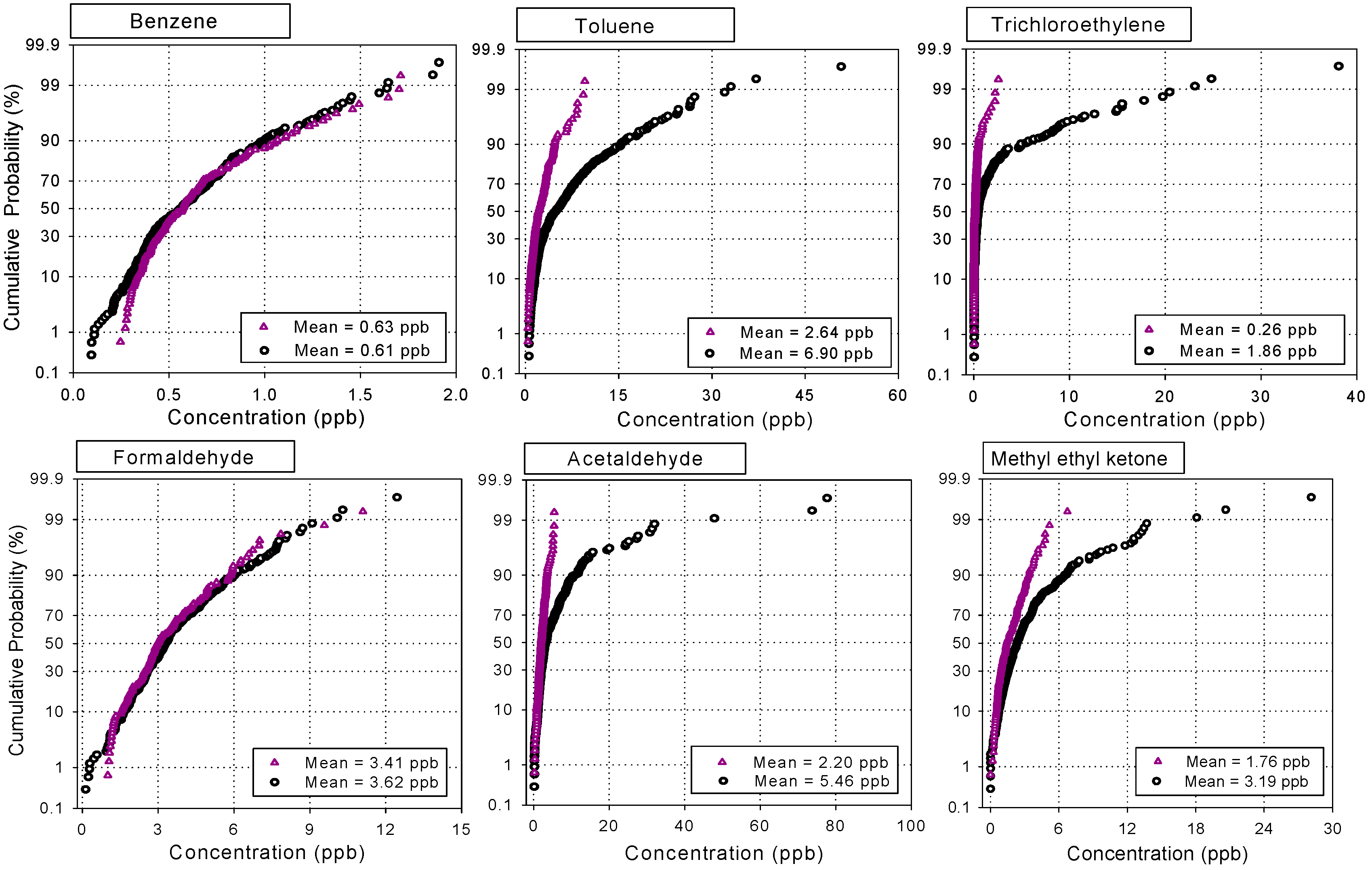

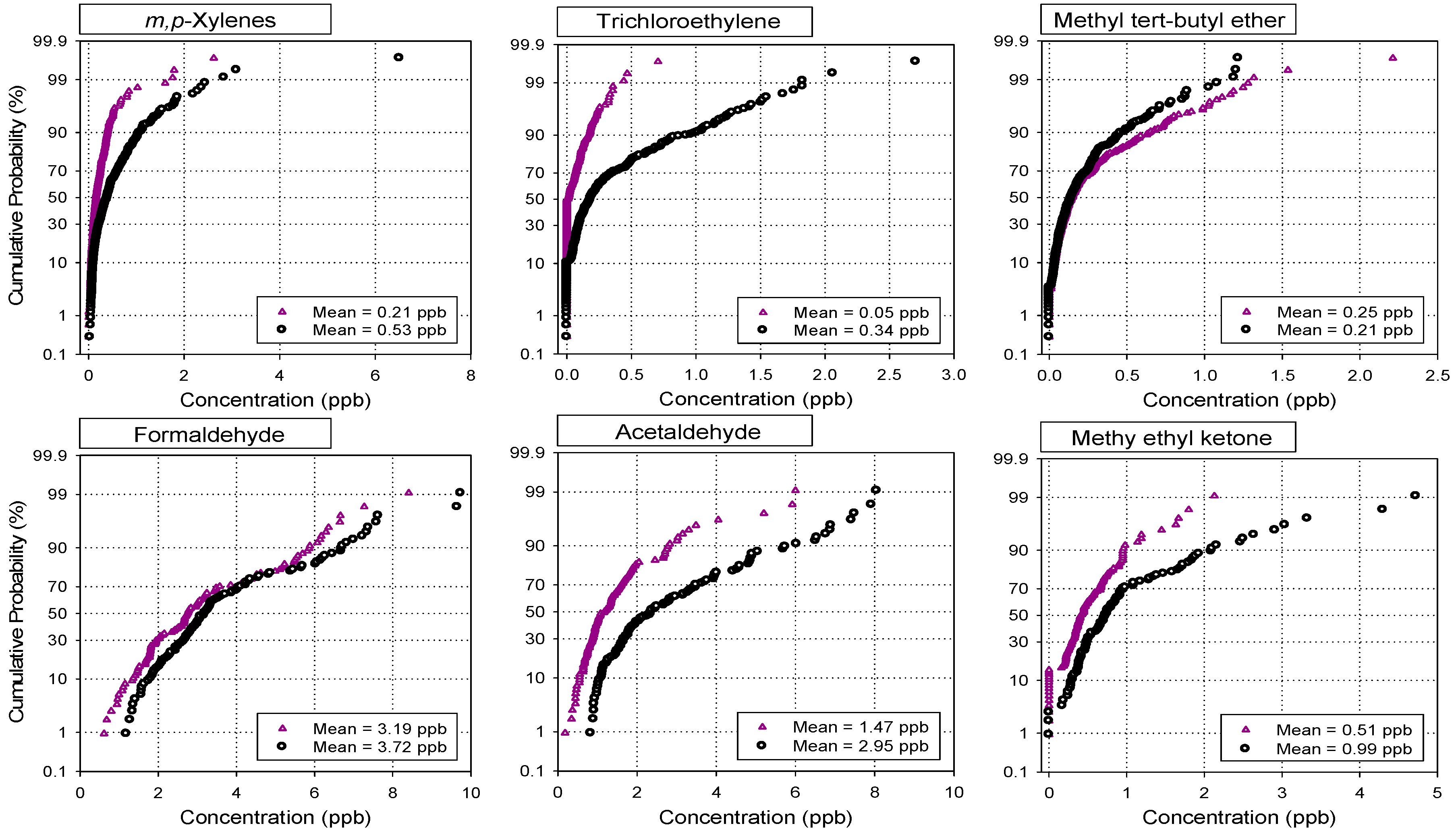
3.4. Temporal Variations of VOCs Concentrations
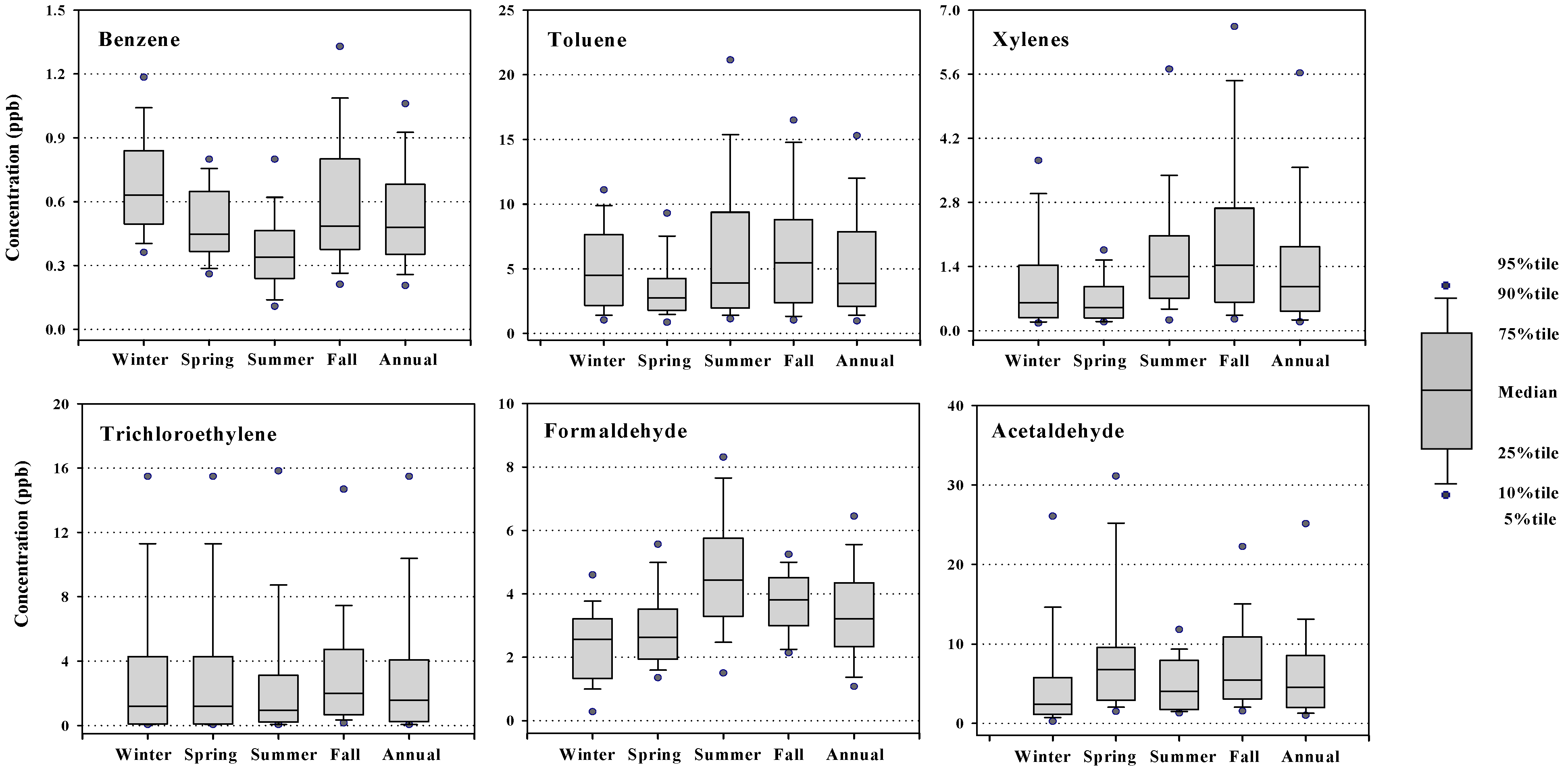

| 2003/2004 Campaign | |||||||
| Sampling Period | Season | Average temp. (°C) | Wind Speed (m/s) | Prevailing Wind Direction | Rain (mm) | ||
| 13~19 January | Winter | 1.6 | 2.0 | W | 1.0 | ||
| 9~15 April | Spring | 20.2 | 1.4 | W | 0.0 | ||
| 13~19 August | Summer | 26.2 | 1.0 | WSW | 56.5 | ||
| 15~21 October | Fall | 17.1 | 1.2 | NW | 0.0 | ||
| 2010/2011 Campaign | |||||||
| Sampling Period | Season | Average temp. (°C) | Wind Speed (m/s) | Prevailing Wind Direction | Rain (mm) | ||
| 21~27 May | Spring | 17.8 | 1.4 | WNW | 50.5 | ||
| 3~9 August | Summer | 28.3 | 1.5 | WNW | 57.0 | ||
| 15~21 October | Fall | 14.3 | 1.2 | WNW | 0 | ||
| 5~11 January | Winter | −3.0 | 2.8 | WNW | 0 | ||
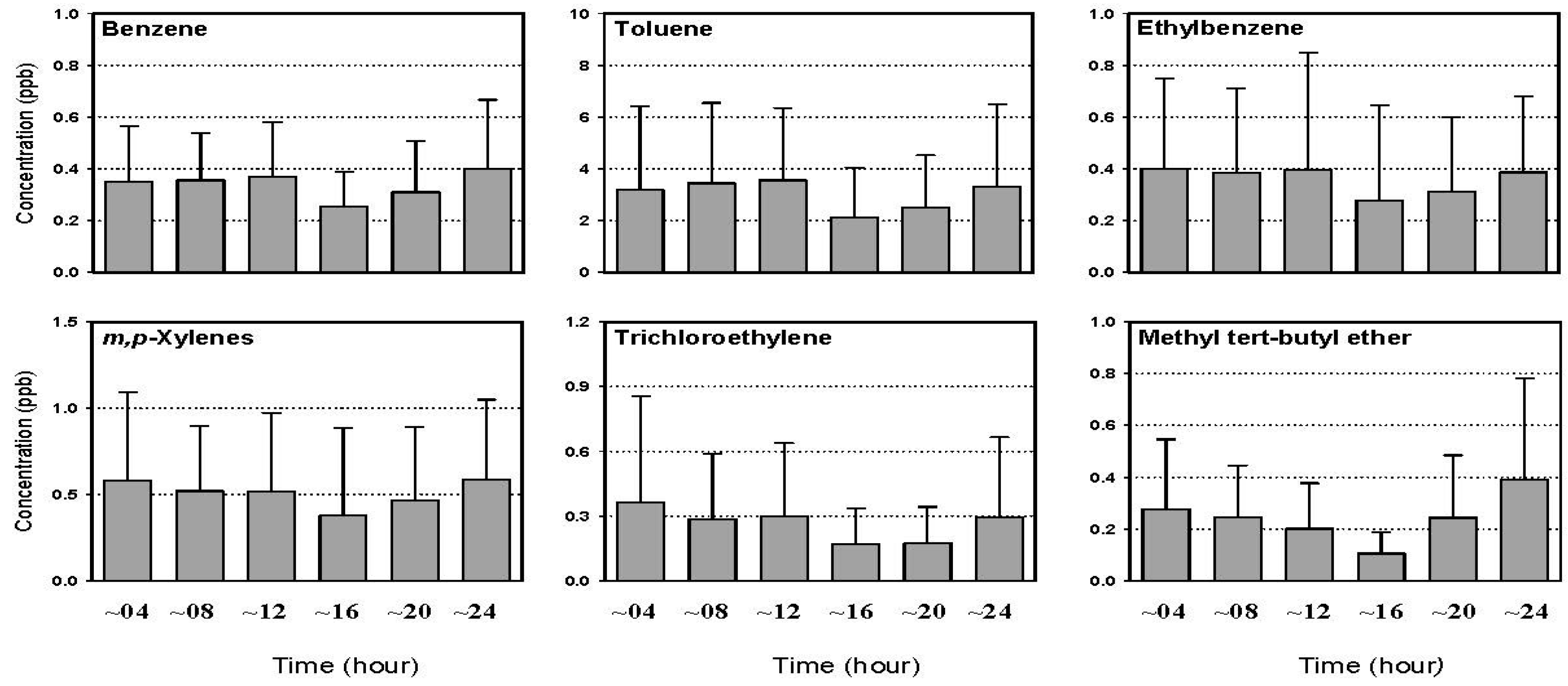
3.5. Comparison of Concentrations of VOCs in 2003–2004 and 2010–2011 in Gumi City
| % Reduction by Mean Concentrations in 2010/2011 Relative to 2003/2004 | |||||
|---|---|---|---|---|---|
| Industrial Site I | Industrial Site II | Residential Site | Commercial Site | Total Mean ± SD | |
| Dichloromethane | 97.6 | 85.7 | 98.2 | 93.1 | 93.6 ± 5.8 |
| n-Hexane | 56.6 | 50.9 | 27.7 | 38.5 | 43.4 ± 15.5 |
| Benzene | 40.7 | 50.0 | 46.7 | 38.8 | 44.1 ± 5.2 |
| Trichloroethylene | 86.9 | 44.9 | 70.0 | 83.9 | 71.4 ± 19.1 |
| Toluene | 45.8 | 61.9 | 59.6 | 54.3 | 55.4 ± 7.1 |
| Tetrachloroethylene | 92.3 | 62.5 | 75.0 | 80.0 | 77.5 ± 12.3 |
| Ethylbenzene | 38.9 | 33.3 | 46.4 | 58.8 | 44.4 ± 11.0 |
| m,p-Xylenes | 49.1 | 46.9 | 59.6 | 58.3 | 53.5 ± 6.4 |
| Styrene | 65.2 | 30.0 | 80.0 | 60.0 | 58.8 ± 21.0 |
| o-Xylene | 40.0 | 32.1 | 50.0 | 50.0 | 43.0 ± 8.7 |
| 1,2,4-Trimethylbenzene | 55.6 | 65.0 | 45.5 | 69.2 | 58.8 ± 10.6 |
| Formaldehyde | −10.9 | 4.9 | 8.4 | 4.8 | 1.8 ± 8.6 |
| Acetaldehyde | 64.9 | 21.3 | 38.9 | 26.3 | 37.9 ± 19.5 |
| Acetone | 85.1 | 86.1 | 87.2 | 86.6 | 86.2 ± 0.9 |
| Methyl ethyl ketone | 56.3 | 72.0 | 69.4 | 71.9 | 67.4 ± 7.5 |
4. Conclusions
Acknowledgments
Author Contributions
Conflicts of Interest
References
- Korea Ministry of Environment. White Paper; Korea Ministry of Environment: Seoul, Korea, 2014; p. 589. (In Korean)
- Korea Ministry of Environment (KMOE). Report of Air Pollution Status on Hazardous Air Pollutants in Korea; KMOE: Seoul, Korea, 2000; p. 156.
- Park, J.M. Management and emissions of hazardous air pollutants from air sources. In Proceedings of the International Symposium on ROK-USA Collaboration for Policies of Air Quality Management, 72–93, Seoul, Korea, 29 November 2011.
- Gumi City. Available online: http://english.gumi.go.kr/open_content/main_page (accessed on 2 February 2015).
- Baek, S.O. Characterization of volatile organic compounds in the ambient air of a large industrial city in Korea. In Proceedings of the Symposium on Air Quality Measurement Methods and Technology, Chapel Hill, NC, USA, 4–6 November 2008.
- Bruhl, R.J.; Linder, S.H.; Sexton, K. Case study of municipal air pollution policies: Houston’s air toxic control strategy under the White Administration, 2004–2009. Environ. Sci. Technol. 2013, 47, 4022–4028. [Google Scholar] [CrossRef] [PubMed]
- Seo, Y.K.; Baek, S.O. Characterization of carbonyl compounds in the ambient air of an industrial city in Korea. Sensors 2011, 11, 949–963. [Google Scholar] [CrossRef] [PubMed]
- Field, R.A.; Goldstone, M.E.; Lester, J.N.; Perry, R. The sources and behaviour of tropospheric anthropogenic volatile organic compounds. Atmos. Environ. 1992, 26A, 2983–2996. [Google Scholar] [CrossRef]
- International Agency for Research on Cancer (IARC). IARC Monographs on the Evaluation of Carcinogenic Risks to Humans; International Agency for Research on Cancer (IARC): Lyon, France, 2012; Volume 100 F. [Google Scholar]
- WHO. Guidelines for Air Quality; WHO: Geneva, Switzerland, 2000; p. 190. [Google Scholar]
- Korea Ministry of Environment. Environmental Statistics Yearbook; Korea Ministry of Environment: Seoul, Korea, 2014; p. 710. (In Korean)
- Korea Ministry of Environment. PRTR Information System; Korea Ministry of Environment: Seoul, Korea, 2010.
- Lung, C.H.; Horng, T.J.; Yu, C.S.; Hsiung, L.K.; Yi, M.S. VOC concentration profiles in an ozone non-attainment area: A case study in an urban and industrial complex metroplex in southern Taiwan. Atmos. Environ. 2007, 41, 1848–1860. [Google Scholar] [CrossRef]
- Hsieh, L.T.; Yang, H.H.; Chen, H.W. Ambient BTEX and MTBE in the neighborhoods of different industrial parks in Southern Taiwan. J. Hazard. Mater. 2006, A128, 106–115. [Google Scholar] [CrossRef] [PubMed]
- Jia, C.; Foran, J. Air toxics concentrations, source identification, and health risks: An air pollution hot spot in southwest Memphis, TN. Atmos. Environ. 2013, 81, 112–116. [Google Scholar] [CrossRef]
- Hoque, R.R.; Khillare, P.S.; Agarwal, T.; Shridhar, V.; Balachandran, S. Spatial and temporal variation of BTEX in the urban atmosphere of Delhi, India. Sci. Total Environ. 2008, 392, 30–40. [Google Scholar] [CrossRef] [PubMed]
- Jia, C.; Batterman, S.; Godwin, C. VOCs in industrial, urban and suburban neighborhoods, Part 1: Indoor and outdoor concentrations, variation, and risk drivers. Atmos. Environ. 2008, 42, 2083–2100. [Google Scholar] [CrossRef]
- Czader, B.H.; Byun, D.W.; Kim, S.T.; Carter, W.P. A study of VOC reactivity in the Houston-Galveston air mixture utilizing an extended version of SAPRC-99 chemical mechanism. Atmos. Environ. 2008, 42, 5733–5742. [Google Scholar] [CrossRef]
- Villanueva, F.; Tapia, A.; Notario, A.; Albaladejo, J.; Martinez, E. Ambient levels and temporal trends of VOCs, including carbonyl compounds, and ozone at Cabaneros National Part border, Spain. Atmos. Environ. 2014, 85, 256–265. [Google Scholar] [CrossRef]
- Simpson, I.J.; Marrero, J.E.; Batterman, S.; Meinardi, S.; Barletta, B.; Blake, D.R. Air quality in the industrial heartland of Alberta, Canada and potential impacts on human health. Atmos. Environ. 2013, 81, 702–709. [Google Scholar] [CrossRef] [PubMed]
- MaCarthy, M.C.; Aklilu, Y.A.; Brown, S.G.; Lyder, D.A. Source apportionment of volatile organic compounds measured in Edmonton, Alberta. Atmos. Environ. 2013, 81, 504–516. [Google Scholar] [CrossRef]
- Tiwari, V.; Hanai, Y.; Masunaga, S. Ambient levels of volatile organic compounds in the vicinity of petrochemical industrial area of Yokohoma, Japan. Air Qual. Atmos. Health 2010, 3, 65–75. [Google Scholar] [CrossRef] [PubMed]
- Liu, P.W.G.; Yao, Y.C.; Tsai, J.H.; Hsu, Y.C.; Chang, L.P.; Chang, K.H. Source impacts by volatile organic compounds in an industrial city of southern Taiwan. Sci. Total Environ. 2008, 398, 154–163. [Google Scholar] [CrossRef] [PubMed]
- Kume, K.; Ohura, T.; Amagai, T.; Fusaya, M. Field monitoring of volatile organic compounds using passive air samplers in an industrial city in Japan. Environ. Pollut. 2008, 153, 649–657. [Google Scholar] [CrossRef] [PubMed]
- Roukos, J.; Riffault, V.; Locoge, N.; Plaisance, H. VOC in an urban and industrial harbor on the French North Sea coast during two contrasted meteorological situations. Environ. Pollut. 2009, 157, 3001–3009. [Google Scholar] [CrossRef] [PubMed]
- Ramirez, N.; Cuadras, A.; Rovira, E.; Borrull, F.; Marce, R.M. Chronic risk assessment of exposure to volatile organic compounds in the atmosphere near the largest Mediterranean industrial site. Environ. Int. 2012, 39, 200–209. [Google Scholar] [CrossRef] [PubMed]
- Celebi, U.B.; Vardar, N. Investigations of VOC emissions from indoor and outdoor painting processes in shipyards. Atmos. Environ. 2008, 42, 5685–5695. [Google Scholar] [CrossRef]
- USEPA. Compendium Method TO-17: Determination of Volatile Organic Compounds in Ambient Air; USEPA: Washington, DC, USA, 1999; p. 49.
- USEPA. Compendium Method TO-11A: Determination of Formaldehyde in Ambient Air using Adsorbent Cartridge Followed by High Performance Liquid Chromatography (HPLC); USEPA: Washington, DC, USA, 1999; p. 51.
- Seo, Y.K.; Suvarapu, L.N.; Cho, B.Y.; Baek, S.O. A study on optimal combination of adsorbents for sampling of C4~C10 hydrocarbons in ambient air and analysis with thermal desorption gas chromatography coupled with mass spectrometry. Asian J. Chem. 2014, 26, 5283–5290. [Google Scholar]
- Seo, Y.K.; Suvarapu, L.N.; Baek, S.O. Monitoring of volatile organic compounds at Gyeongju: A historical and tourist place in South Korea. Asian J. Chem. 2014, 26, 2493–2499. [Google Scholar]
- Baek, S.O.; Jenkins, R.A. Characterization of trace organic compounds associated with aged and diluted sidestream tobacco smoke in a controlled atmosphere—Volatile organic compounds and polycyclic aromatic hydrocarbons. Atmos. Environ. 2004, 38, 6583–6599. [Google Scholar] [CrossRef]
- Baek, S.O.; Jenkins, R.A. Performance evaluation of simultaneous monitoring of personal exposure to environmental tobacco smoke and volatile organic compounds. Indoor Built Environ. 2001, 10, 200–208. [Google Scholar] [CrossRef]
- USEPA. Determination and Procedure for the Determination of the Method Detection Limit, Code of Federal Regulations, Part 136, Appendix B; USEPA: Washington, DC, USA, 1990; p. 537.
- Feng, Y.; Wen, S.; Chen, Y.; Wang, X.; Lű, H.; Bi, X.; Sheng, G.; Fu, J. Ambient levels of carbonyl compounds and their sources in Guangzhou, China. Atmos. Environ. 2005, 39, 1789–1800. [Google Scholar] [CrossRef]
- Pang, X.; Mu, Y. Seasonal and diurnal variations of carbonyl compounds in Beijing ambient air. Atmos. Environ. 2006, 40, 6313–6320. [Google Scholar] [CrossRef]
- Kim, K.H.; Choi, Y.J.; SunWoo, Y.; Baek, S.O.; Jeon, E.C.; Hong, J.H. The emissions of major aromatic VOC as landfill gas from urban landfill sites in Korea. Environ. Monit. Assess. 2006, 118, 407–422. [Google Scholar] [CrossRef] [PubMed]
- Sing, H.B.; Salas, L.; Viezee, W.; Ferek, R. Measurement of volatile organic chemicals at selected sites in California. Atmos. Environ. 1992, 26A, 2929–2946. [Google Scholar] [CrossRef]
- Wrbitzky, R. Liver function in workers exposed to N,N-dimethylformamide during the production of synthetic textiles. Int. Arch. Occup. Environ. Health 1999, 72, 19–25. [Google Scholar] [CrossRef] [PubMed]
- Altshuller, A.P. Production of aldehydes as primary emissions and from secondary atmospheric reactions of alkenes and alkanes during the night and early morning hours. Atmos. Environ. 1993, 27, 21–32. [Google Scholar] [CrossRef]
- Northway, M.J.; Gouw, J.A.; Fahey, D.W.; Gao, R.S.; Warneke, C.; Roberts, J.M.; Flocke, F. Evaluation of the role of heterogeneous oxidation of alkenes in the detection of atmospheric acetaldehyde. Atmos. Environ. 2004, 38, 6017–6028. [Google Scholar] [CrossRef]
- Grutter, M.; Flores, E.; Andraca-Ayala, G.; Báez, A. Formaldehyde levels in downtown Mexico City during 2003. Atmos. Environ. 2005, 39, 1027–1034. [Google Scholar] [CrossRef]
- Tanner, R.L.; Meng, Z. Seasonal variations in ambient atmospheric levels of formaldehyde and acetaldehyde. Environ. Sci. Technol. 1984, 18, 723–726. [Google Scholar] [CrossRef]
- Moussa, S.G.; el-Fadel, M.; Saliba, N.A. Seasonal, diurnal and nocturnal behaviors of lower carbonyl compounds in the urban environment of Beirut, Lebanon. Atmos. Environ. 2006, 40, 2459–2468. [Google Scholar] [CrossRef]
- Liu, Y.; Yuan, B.; Li, X.; Shao, M.; Lu, S.; Li, Y.; Chang, C.C.; Wang, Z.; Hu, W.; Huang, X.; et al. Impact of pollution controls in Beijing on atmospheric oxygenated volatile organic compounds (OVOCs) during the 2008 Olympic Games: observation and modeling implications. Atmos. Chem. Phys. 2015, 15, 3045–3062. [Google Scholar] [CrossRef]
- Korea Ministry of Environment (KMoE). Present Status of Designated area for Odor Control, KMoE; Korea Ministry of Environment (KMoE): Seoul, Korea, 2009.
© 2015 by the authors; licensee MDPI, Basel, Switzerland. This article is an open access article distributed under the terms and conditions of the Creative Commons Attribution license (http://creativecommons.org/licenses/by/4.0/).
Share and Cite
Baek, S.-O.; Suvarapu, L.N.; Seo, Y.-K. Occurrence and Concentrations of Toxic VOCs in the Ambient Air of Gumi, an Electronics-Industrial City in Korea. Sensors 2015, 15, 19102-19123. https://doi.org/10.3390/s150819102
Baek S-O, Suvarapu LN, Seo Y-K. Occurrence and Concentrations of Toxic VOCs in the Ambient Air of Gumi, an Electronics-Industrial City in Korea. Sensors. 2015; 15(8):19102-19123. https://doi.org/10.3390/s150819102
Chicago/Turabian StyleBaek, Sung-Ok, Lakshmi Narayana Suvarapu, and Young-Kyo Seo. 2015. "Occurrence and Concentrations of Toxic VOCs in the Ambient Air of Gumi, an Electronics-Industrial City in Korea" Sensors 15, no. 8: 19102-19123. https://doi.org/10.3390/s150819102
APA StyleBaek, S.-O., Suvarapu, L. N., & Seo, Y.-K. (2015). Occurrence and Concentrations of Toxic VOCs in the Ambient Air of Gumi, an Electronics-Industrial City in Korea. Sensors, 15(8), 19102-19123. https://doi.org/10.3390/s150819102





